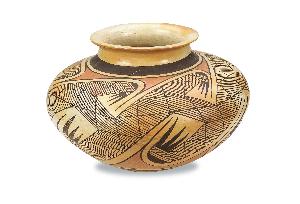Fannie Lesou Polacca, Fannie Nampeyo Polacca
Fannie Lesou Polacca, Fannie Nampeyo Polacca;Fannie Nampeyo
Place: First Mesa
Born: 1900
Death: 1987
Biography:
Biography
Fannie Nampeyo Polacca, also known as Fannie Lesou Polacca and Fannie Nampeyo Polacca, was a renowned modern and contemporary fine arts potter from the United States. Born in 1900, she was the youngest of three daughters of the famous potter Nampeyo of Hano, the grand matriarch of modern Hopi pottery. Fannie's life was marked by her dedication to preserving and innovating the traditional Hopi pottery techniques.
Early Life and Education
Fannie was born in the Hopi-Tewa Corn Clan home atop First Mesa, on the Hopi Reservation in Arizona. She was given the name Popongua or Popong-Mana by the older women of her father Lesou's family. Fannie completed her education up to the third grade and later married her cousin, Vinton Polacca, in the early 1920s. The couple moved to Sand Hills, where Vinton worked as a cattle rancher, and Fannie began taking pottery seriously.
Pottery Career
Fannie's pottery career spanned over six decades, from 1920 to 1987. She earned a reputation as an outstanding potter during her lifetime, known for her black and red on yellow and black on yellow designs in the form of jars, cups, and saucers. Her favorite designs included clouds, rain, feathers, stars, and migration motifs. Fannie's pottery won a first place blue ribbon in the "Hopi Show" at the Museum of Northern Arizona in July 1961. Pottery Styles and Techniques Fannie's pottery styles included:
- Black and red on yellow
- Black on yellow
- Miniatures
- Bird effigy bowls
Awards and Recognition
Fannie's work has been recognized and collected by several museums, including the University of Oklahoma's Fred Jones Jr. Museum of Art and The Cleveland Museum of Art. Her pottery is also featured on Wikioo.org, where her Hopi-Tewa polychrome jar is showcased.
Legacy
Fannie Nampeyo Polacca passed away in 1987, leaving behind a legacy of Hopi pottery that continues to inspire and influence contemporary potters. Her children, including Elva Nampeyo, have followed in her footsteps, becoming renowned potters in their own right. For more information on Fannie's life and work, visit her page on Wikipedia.

